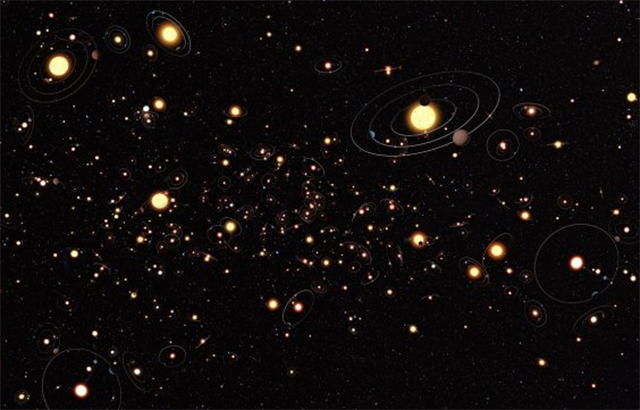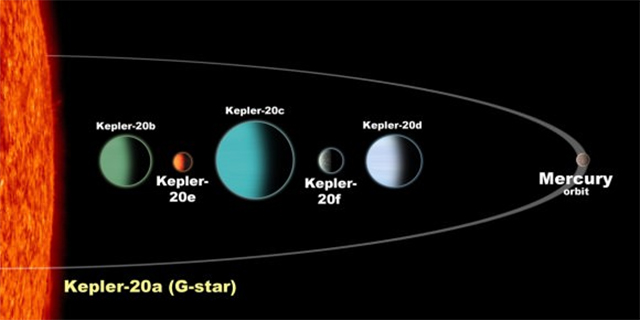
In 1960, Freeman Dyson proposed how advanced civilizations could create megastructures that enclosed their system, allowing them to harness all of their star's energy and multiplying the habitable space they could occupy.
In 2015, the astronomical community was intrigued when the star KIC 8462852 (aka. Tabby's Star) began to dim inexplicably. While an analysis of the star's light curve in 2018 revealed that the dimming pattern was more characteristic of dust than a solid structure, Tabby's Star focused attention on the concept of megastructures and their associated technosignatures.
Dyson's ideas were proposed at a time when astronomers were unaware of the abundance of exoplanets in our galaxy. The first confirmed exoplanet was not discovered until 1992, and that number has now reached 5,514!
With this in mind, a team of researchers from Bangalore, India, recently released a paper that presents an alternative to the whole megastructure concept. For advanced civilizations looking for more room to expand, taking planets within their system – or capturing free-floating planets (FFP) beyond – and transferring them into the star's circumsolar habitable zone (HZ) is a much simpler and less destructive solution.
The research was led by Raghav Narasimha, a physics graduate student at Christ University in Bangalore, India. He was joined by Margarita Safonova and Chandra Sivaram, a Department of Science and Technology (DST) Woman Scientist and a professor of astrophysics (respectively) at the Indian Institute of Astrophysics (IIAP) in Bangalore, India.
The preprint of their paper, "Making Habitable Worlds: Planets Versus Megastructures," recently appeared online and is being reviewed for publication in Astrophysics and Space Science.
The problem with megastructures
The possibility of advanced civilizations building giant structures to harness the energy of their stars is time-honored, with examples going back to the early 20th century. The earliest examples include John Desmond Bernal's "Bernal Sphere," which he detailed in his 1929 work The World, the Flesh & the Devil.
According to Bernal, the source of the material for building such structures "would only be in small part drawn from the Earth; for the great bulk of the structure would be made out of the substance of one or more smaller asteroids, rings of Saturn or other planetary detritus."
Olaf Stapledon took things a step further in his science fiction novel Star Maker, where he described how a future advanced human civilization was "able to construct, out in space, artificial planets for permanent habitation. These great hollow globes of artificial super-metals and artificial transparent adamant, ranged in size from the earliest and smallest structures, which were no bigger than a very small asteroid, to spheres considerably larger than the Earth."
These sources may have been the source of inspiration for Dyson's 1960 proposal paper.
In this seminal paper, "Search for Artificial Stellar Sources of Infrared Radiation," Dyson reasoned that a civilization's motivations for building an "artificial biosphere" (later dubbed a "Dyson Sphere" by Nikolai Kardashev) would include harnessing energy but also multiplying the amount of space they could inhabit.
Beginning with the likely possibility that civilization observed at cosmic distances would be much older and more advanced than humanity, he argued that:
"[It is] a reasonable working hypothesis that their habitat will have been expanded to the limits set by Malthusian principles.
We have no direct knowledge of the material conditions which these beings would encounter in their search for lebensraum… One should expect that, within a few thousand years of its entering the stage of industrial development, any intelligent species should be found occupying an artificial biosphere which completely surrounds its parent star."
However, at the time of writing, Dyson was working with the limits of habitable space within our Solar System, which was confined to Earth. Nevertheless, the various bodies of the Solar System (particularly Jupiter and the gas giants) have a tremendous amount of material that could (in theory) be repurposed to create an artificial biosphere.
Using Jupiter as an example, Dyson argued that the planet's mass was sufficient to create a spherical shell around the Sun about 2 to 3 meters (6.5 to 10 ft) in thickness with a density of "200 grams per square centimeter."

Moreover, inspired by recent advances in infrared astronomy, Dyson suggested how SETI researchers could look for evidence of these structures in our galaxy by their heat signatures.
As Narasimha, Safonova, and Sivaram told Universe Today via email:
"Dyson suggested that advanced ET civilizations could already have constructed such megastructures. These would be radiating the entire star's energy chiefly in the narrow infrared (IR) range of 8 to 10 microns (because of the "waste heat" – observed as excess IR radiation), so this should be the technosignature of such a structure, i.e., the stellar object with solar luminosity but all radiating in the IR.
"Carl Sagan and Russel Walker suggested in 1966 in the paper "The Infrared Detectability of Dyson Civilizations" to search for Dyson civilizations using IR space telescopes. Astronomers still continue to look for such objects, though with negative results till now, because the concept is not limited to time – any long-term civilization (i.e., lasting for thousands of years) may ultimately require the entire output of their host star."
As an alternative, Narasimha and his colleagues suggest how multiple planets could be moved within the Sun's HZ, which would multiply the livable space in our Solar System and not require the destruction of its planets.
Furthermore, based on our current understanding of planetary bodies, they identified several issues with Dyson's original calculations and assumptions. For instance, Dyson's premise of using Jupiter as a resource did not acknowledge that only a fraction of Jupiter's mass (approximately 13 percent) could be used for construction purposes.
This includes the rocky interior and metallic core, whereas hydrogen and helium (which account for 87 percent of its mass fraction) could not be practically used as building materials. What's more, the abundant hydrogen could be used in fusion reactors, offering a much simpler and practical solution to any energy crisis.
Dyson's proposal was based on the theory that population growth will invariably outstrip a species' resource base (aka. Malthusian Theory), which has been criticized extensively for failing to consider technological advancement and other factors influencing population dynamics.
Narasimha and his colleagues also argue that enclosing a star like our Sun would trap all of its solar wind inside, leading to the disappearance of the heliosphere and exposing the Dyson Sphere to elevated levels of cosmic rays – potentially harming the biosphere inside. This is one of several issues (both technical and ethical) that the team identified with Dyson's original proposal:
"To construct such a megastructure, we would need to use up all inner planets and some of the outer planets, therefore completely destroying the Solar System as we know it now, including the Earth with its unique biosphere. This also goes against the principle of Planetary Protection – the UN policies governing the preservation of the Solar System bodies. In addition, in our Solar System, Jupiter's gravity deflects the asteroids, diminishing the possibility of collision with Earth – the dramatic example in 1994 was the Levy-Shoemaker comet. The sphere (or even a ring) would be very unstable against slight perturbations (for example, a meteorite hit) and will collide with the central star."
"[T]he inside of a solid Dyson Sphere would have no gravity unless it is rotating, and then only on the equator will the gravity be the usual 1 g. The illumination will be continuous with no nights, and the interior with an Earth-like surface will reflect the sunlight with Earth albedo, making the sky much brighter than a day-lit Earth. Since our Sun will remain the same active star – there would be no protection from solar flares, CMEs, solar wind, etc., as there would be no natural magnetic field. And relatively soon on the cosmic timescale, our Sun will start expanding into a red giant, absorbing everything out to Jupiter's orbit!"
Lastly, they point to the timescales for building a Dyson Sphere, which would be immense. This does not consider civilizations' potential long-term stability and sustainability over long periods (the L parameter in the famous Drake Equation).
Under the circumstances, creating a megastructure not only seems like a major undertaking but also impractical and inadvisable.
Planets everywhere!
In Dyson's time, it was generally assumed that most stars had a system of at least one planet. Based on data obtained by the Kepler Space Telescope and other planet-finders – such as Hubble, the Transiting Exoplanet Survey Satellite (TESS), and the James Webb Space Telescope (JWST) – astronomers estimate that there could be at least 100 billion planets in our Milky Way. Recent research has also revealed that there could be as many as a trillion free-floating planets (FFP), aka. "rogue planets," in our galaxy.
If these planets could be moved into a star's habitable zone, it would exponentially increase a civilization's real estate. As the team explained, an advanced civilization could also import new planets as needed over time and/or designate planets for different purposes.
"There is no need to destroy entire planetary systems," they said. "ETI could bring in a planet, use it up, kick it out of the system, and bring another one. Planets used only for industrial and technological purposes are called 'Service Worlds.' ETI could even bring in free-floating planets to use it as Service Worlds."
In their paper, the team showed how water-rich planets like Mars or Pluto, or many icy trans-Neptunian objects (TNOs), could be shifted into the Solar System's HZ using powerful laser arrays. These lasers would need to be in the Zetawatt or Etawatt (1024 W) power range, the former of which is already used for nuclear fusion research.
According to their estimates, the power and total energy used would be several orders of magnitude less than what is required to break apart Jupiter (and other planets) to build a Dyson Sphere.
In addition to the material benefits, an advanced civilization capable of moving planets around in their system could also alter the orbital mechanics of these worlds. This idea was also elucidated by Tsiolkovsky in 1895, where he wrote of advanced people who could alter the daily cycles, length of year, and seasonal temperatures on their planets whenever they felt the need to.
Naturally, this study raises the question of how SETI researchers could search for such civilizations and what "technosignatures" they would produce.
Whereas Dyson showed how megastructures could be detected by their signatures in infrared wavelengths, Narasimha and his colleagues indicate that engineered systems of planets would produce distinct technosignatures.
This includes powerful narrowband laser arrays, which would be detectable over distances of hundreds or even thousands of light-years. This is consistent with the recommendations of Prof. Philip Lubin, a professor of physics at UC Santa Barbara and the leader of the UCSB Experimental Cosmology Group (ECG).

In 2016, Prof. Lubin published a paper indicating that an advanced civilization could be detected by searching for "spillover" from laser arrays. These could be used for communication, propulsion, and asteroid defense – the very applications Lubin and his colleagues at the ECG are researching for use here on Earth (including Breakthrough Starshot).
In 2018, NASA's Technosignature Report was released, which included "optical communications," laser propulsion, and other directed-energy methods as viable technosignatures.
Moreover, Narasimha and his team explained how engineered systems would have a vastly different profile from other systems. They even offer some potential examples SETI researchers could examine more closely in the coming years:
"If the planets are arranged strangely, i.e., the masses of planets alternative from one planet to another (like a gas giant, a terrestrial planet, then a terrestrial planet, and another a gas giant – like the Kepler-20 system), then we could consider that these unusual arrangements were made by ETI intentionally. Planetary systems such as Kepler-20, or TRAPPIST-1, where many Earth-like (low-mass rocky planets) are arranged close to their star, at a distance less than Mercury's orbit, is another possible indication of an advanced ET astroengineering. It seems unusual to see so many terrestrial-type planets in such a narrow zone at a short distance from their star. This could suggest that such planets could have been deliberately moved into the HZ of their parent stars."
In short, Narasimha and his team recommend that astronomers look for Strange Exoplanetary Architectures (SEAs) as one of the search parameters when looking for biosignatures and technosignatures.
Future SETI efforts may include the search for modified or arranged systems that indicate the presence of multiple habitable planets, "Service Worlds," and advanced communication and infrastructure between them. Who knows? Perhaps some systems will include multiple stars, each with its own arrangement of planets that support multiple civilizations.
In short, we should keep our eyes open for any "Firefly" verses!
Further Reading: arXiv
This article was originally published by Universe Today. Read the original article.





An advanced civilisation capable of building mega structures would have fully decoded the quantum fields that are the digital building blocks of the simulation less intelligent people still perceive as their 'reality'. Thus they would have no need, whatsoever to harness energy. Energy they simply could produce themselves on the fly by turning matter into energy directly, on a quantum level, and vice versa reproduce any given collection of quantum fields either by observing them into existence or by altering the quantum state of already observed matter, i.e garbage, in order to quickly produce whatever they may need and or desire (water, food, housing closing cars, spacecrafts, whole planets and stars if need be and possibly even living organisms). This is also called as quantum replication.
ReplyDelete